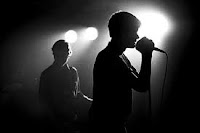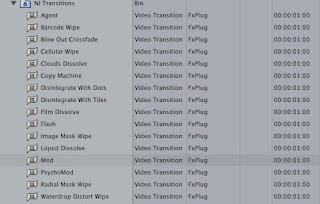 Black & White: Taking influence from the work of Anton Corbijn, we will desaturate our music video. Black and white gives the intended timeless appeal, as well as helping signify the bleak moods of the song. To emphasise this editing, we will also probably boost the contrast of the video, especially in the cold turkey scenes. This will make the black and white more dynamic and strong, as well as linking back to classic Joy Division imagery.
Black & White: Taking influence from the work of Anton Corbijn, we will desaturate our music video. Black and white gives the intended timeless appeal, as well as helping signify the bleak moods of the song. To emphasise this editing, we will also probably boost the contrast of the video, especially in the cold turkey scenes. This will make the black and white more dynamic and strong, as well as linking back to classic Joy Division imagery.Chroma Key: Chroma key is used to isolate one colour in a shot. We plan to use this on the first close up shot of the cigarette. Isolating the orange/red of the embers will create a striking appearance, and connote the importance of the cigarette.
Cutting (to the beat): The pace of the song is fairly fast so we will match this in terms of our shot durations. The pacing of the cold turkey scenes will be much faster than the rest in order to stand out, and as the song builds towards the end we can also user quicker cuts. The very end of the song will use slow, long takes. Where the are prominent instrumental riffs or strong drum beats, we can also match this to the editing so that they work together rather than being seperate to one another.
Multi-layering: This is another technique often used by Corbijn. It works most successfully when one shot is more of a close up and the other a wider frame. Overlaying the two with the opacity of the top layer reduced creates a nicer visual appeal to a shot that perhaps alone would have been boring. We have considered using this on the bridge scene to perhaps intercut other parts of the video, but also using it in the cold turkey scenes to make it more frantic in parts.
 Split-Screen: We plan to use this on one particular shot of the protagonist looking out on to the road (in the bridge scene). Whilst the half with the character will play at normal speed, the other half will be sped up creating an almost timelapse style visual to the cars. It will make an interesting climax.
Split-Screen: We plan to use this on one particular shot of the protagonist looking out on to the road (in the bridge scene). Whilst the half with the character will play at normal speed, the other half will be sped up creating an almost timelapse style visual to the cars. It will make an interesting climax.Transitions: Again we don't expect to use overly complex transitions in the video. From what we have seen of Final Cut, we expect to use lots of cross-fades, flash transitions, and the video will fade in and out. We are currently thinking the end will fade to white. From our research on music videos, especially this genre, we have seen that in general transitions are kept minimal, this is largely due to the fact they can slow down the pace of a music video, which is normally not the intention.
No comments:
Post a Comment